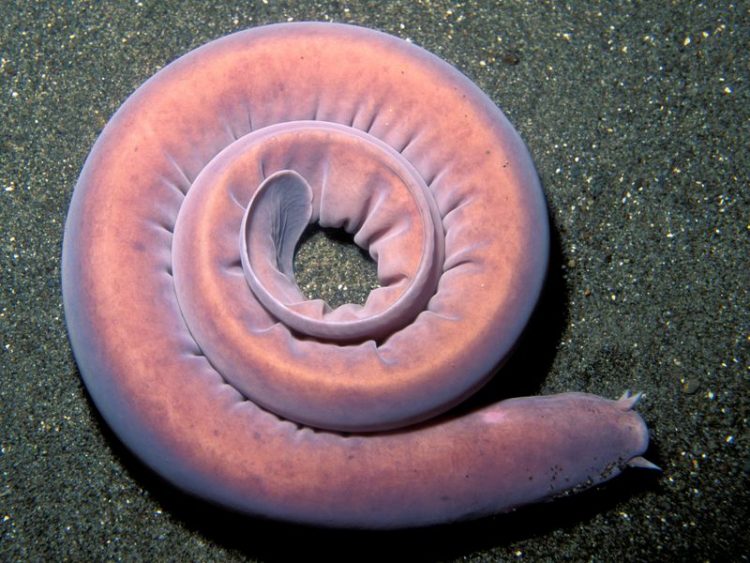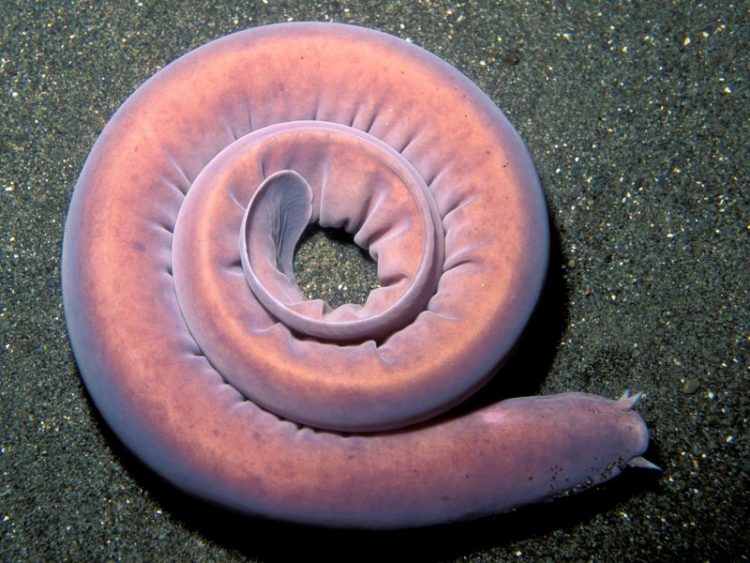At first glance, the humble hagfish looks like just another species of ocean-dwelling eel, but they are something much weirder and at the same time fascinating. From the bizarre slime-like substance it produces as a defense mechanism, to the lack of a backbone, there’s a whole lot of weirdness to address.
The hagfish is a primitive, virtually blind creature that spends its life on the bottom of the ocean, slithering and feeding mostly on dead or dying fish. Among the several things that make the hagfish unique is its body structure. It has a skull, but no jaw and no vertebral column. This allows them to tie their bodies into knots in order to scrape the sticky slime they produce off of their skin. They can burrow into dead or dying animals through various orifices and even through their skin – using two rows of keratinous teeth – and devour them from the inside. But they don’t really need the teeth, as they can absorb nutrients through the skin and can go months without eating. Pretty freaky stuff, and we haven’t even talked about their slime-producing capabilities.

Lacking eyes and teeth, the hagfish seem pretty defenseless, but they have a secret weapon that is capable of keeping most predators at bay. When threatened or scared, these slithering ocean dwellers release a type of sticky slime-like structure that can trap, slow down, and even suffocate attackers, allowing them to get away. But it’s the way that this slime works that is truly fascinating.
Hagfish produce the gelatinous slime from pairs of pores that run the length of their bodies. One type of gland produces a complicated coiled mucus thread that is estimated to be about six inches long, and the other, a sort of slime bubble. The threads spread out and entangle one another, creating a fast-expanding net that traps both mucus and water.
The average hagfish will produce about a teaspoon of this mucus, but in less than half a second it expands by 10,000 times, enough to fill a bucket. The high density of the slime is enough to deter most predators from pursuing the hagfish once it has made contact with it.
“The slime sets up very quickly and is incredibly good at sticking to and clogging gills, so fish typically abort their attacks on hagfishes because they can’t deal with the slime,” Douglas Fudge, a biomaterials researcher at Chapman University, told National Geographic.
Luckily, coming in contact with hagfish slime is a rare occurrence for humans. However, it once was at the center of one of the strangest road accidents ever recorded. A truck transporting hackfish was involved in a crash, and the slithering creatures wound up on the road, covering it in a thick, sticky layer of much that had to be cleared with a small bulldozer before normal traffic could resume.
There’s no denying that the slime looks disgusting, but many scientists describe it as one of the most wondrous substances ever discovered. For starters, its appearance alone can be misleading. It looks like slime, but it’s actually more like a spider’s web in nature. These threads spread out and entangle one another, creating a fast-expanding net that traps both mucus and water. They are about 10 times stronger than nylon, thinner than human hair, and extremely flexible.
Hagfish slime is one of the softest materials found in nature. It is between 10,000 and 100,000 times softer than Jell-O and it even looks like simple water at first glance. It’s only when inserting your hand in it that you can tell it’s something different.
Even after decades of studying hagfish, scientists are only just beginning to understand the process through which these creatures produce the slime-like substance. The mechanism is still one big mystery, as no one can quite understand how they are able to coil the threads into structures akin to microscopic balls of yarn that rapidly expand after they leave the pores on the creature’s skin.
Because of the unique properties of hagfish “slime”, it has caught the imagination of scientists, who hope to somehow create an artificial material with a wide array of applications. We may one day be able to create fabric out of hagfish slime, an environmentally-friendly alternative to petroleum-based synthetic fabrics. Some have theorized that the slime could also be used in protective gear such as safety helmets and Kevlar vests, or as a protective layer for divers. In medicine, it could prove useful in tissue engineering and replacing damaged tendons.
Meanwhile, to the average person, the hagfish remains a gross, slime-spewing sea monster. It’s not the best-looking creature on God’s earth, and the fact that simply touching it leaves your hand covered in sticky gunk doesn’t help much either.













